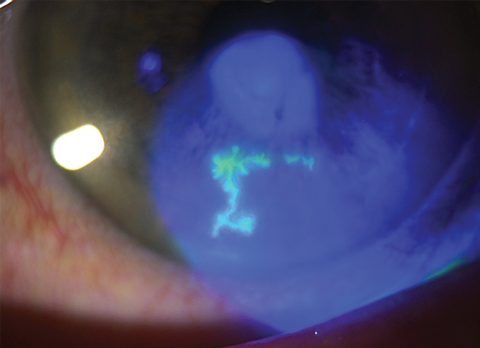 |
| HSV may cause ocular disease in more patients than previously observed. Photo: Lisa Martén, MD. Click image to enlarge. |
Herpes simplex virus (HSV) is a lifelong infection characterized by periodic recurrences in some patients. It’s found across the globe, and an estimated 4.85 billion people of all ages suffer from HSV-1 infection, which is associated with orolabial, ocular and neurological conditions. Researchers recently compiled available data on HSV keratitis and other HSV ocular disease incidence rates to estimate the global burden. They found that herpetic eye disease burden is likely underestimated.
“Ocular disease can result from a primary HSV infection of the eye or accompany a primary extraocular HSV infection,” the researchers explained. “However, it typically occurs following reactivation of latent infection acquired at an extraocular oral or facial site.” They also noted that it’s most prevalent in the World Health Organization (WHO) Africa and Americans regions.
To estimate the incidence and global burden of HSV keratitis and HSV ocular diseases, the researchers conducted a Medline and Embase database search for studies reporting incidence rates. They evaluated each study for quality and used pooled estimates to estimate global HSV ocular disease burden. They estimated numbers with uniocular vision impairment (defined as visual acuity <6/12) by applying published risks to case numbers.
The review turned up 14 studies, of which seven met inclusion criteria. The team reported that in 2016, an estimated 1.7 million people had HSV keratitis based on a pooled incidence of 24 per 100,000 person-years. A majority had epithelial keratitis. “Of these, 1.7 million individuals, approximately 230,000 people (~15%), may have newly acquired some degree of uniocular vision impairment (mild or worse) associated with HSV keratitis in 2016,” the researchers wrote.
Importantly, they noted in their paper that these figures likely underestimate the true burden of HSV ocular disease. “Data were more limited for rarer but potentially more vision-impairing conditions such as HSV uveitis and retinitis,” they explained. “We tentatively estimated that around 0.1 million cases of HSV uveitis might have occurred in 2016, although the fractions of uveitis alone and episodes that were concurrent to other ocular HSV disease were unknown.
“Our study represents the most recent review of the literature on HSV keratitis incidence and the only review to our knowledge of the incidence of HSV keratitis and other clinically relevant ocular disease caused by HSV infections,” they wrote. “We were able to generate the first global estimates of the number of people separately with epithelial and stromal HSV keratitis and with new vs. recurrent keratitis.”
Limitations of the study included the small number of available studies on which to base estimates and the inclusion of a single reviewer (due to resource constraints). The investigators also noted that while population-based surveys of vision impairment and eye disease have yielded epidemiological estimates for chronic conditions such as cataract, there were few studies for acute, episodic or less common conditions associated with HSV, such as uveitis and retinitis. “As there was a lack of good-quality data on the incidence of HSV uveitis and retinitis, we may have failed to capture an important contributor to the magnitude of vision impairment due to ocular HSV.” They also noted a degree of uncertainty concerning diagnoses in most of the studies that were based on clinical presentation alone. “Misdiagnosis may lead to over- or under-estimation of incidence,” they said.
“Differences may [also] exist in disease incidence across populations, particularly by age and by geographic location. The paucity of estimates meant we were unable to carry out a stratified analysis of incidence, and our global burden estimates were derived by applying one single pooled estimate of incidence per clinical entity universally across world population estimates.”
“Of particular note,” they continued in their paper, “HSV ocular disease incidence is likely to be closely related to rates of HSV-1 infection. All studies contributing data to our pooled estimates were conducted either in Europe or in the USA. The WHO Americas and Europe regions have the lowest prevalence of oral HSV-1 infection of all WHO regions, meaning the incidence of HSV ocular disease is likely to be higher outside Europe and the Americas, and our figures for the global burden of disease are therefore likely to be underestimates. However, the relationship between HSV infection rates and ocular disease rates is unclear, as there may be contributing factors such as age at which individuals generally acquire infection, the site of original HSV-1 infection (oral vs. genital) and other factors.”
The researchers concluded, improved access to evidence-based treatment in low- and middle-income countries could help reduce ocular morbidity globally.” They also emphasized prevention via vaccines to reduce the global burden for both ocular- and HSV-associated genital, oral and neonatal disease.
McCormick I, James C, Welton NJ, et al. Incidence of herpes simplex virus keratitis and other ocular disease: Global review and estimates. Ophthalmic Epidemiol. October 8, 2021. [Epub ahead of print]. |

